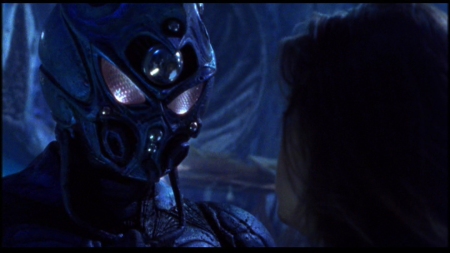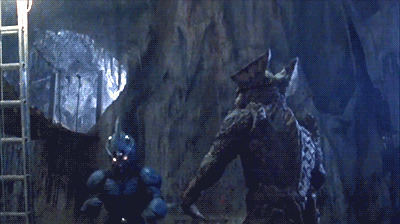In this running series, I’ve had films with martial arts, films based on Japanese comic books and films that are pure B-movie scifi trash… So how about a film with all three of those elements?

Guyver: Dark Hero is the second of two live action Guyver movies, based on a Japanese manga and animated series of the same name. The first movie (released in the UK as the bizarrely-titled Mutronics) was very much an Americanisation of the source material- Japanese high-schooler protagonist Sho Fukamachi is replaced by white westerner Sean Barker, for example- and is based on a condensed version of the story told in the first few issues of the manga. The second film is somewhat more original in it’s plot, although it takes several ideas and themes from the manga and the anime and puts them in a blender with some B-movie horror set pieces and adds a significant amount of martial arts fighting to the resulting smoothie.
I’d seen the first Guyver film reviewed on some late night channel four schedule-filler show and scoured our local video shop for it as a result. I must’ve been about 11 or 12 at the time and I thought the film was awesome (it really wasn’t!) and it was what got me into manga a couple of years later. Guyver: Dark Hero hit our video shop shelves at some point in 1994. By this point, I was really into martial arts movies and Japanese comic books, so the film was an instant rental and soon became one of my favourite films.

The story of Guyver: Dark Hero continues on from the first. A year ago, Sean Barker came into possession of a piece of alien technology- the guyver, a biological suit of armour that encases its host and augments their combative abilities, complete with a selection of funky weaponry. The Chronos Corporation, the guyver unit’s original finders, are the bad guys of the piece- they are in the business of secretly unearthing this alien tech and have a slew of shape-shifting super soldiers at their disposal for the purposes of… conquering the world. Of course. After destroying Chronos in the first film, Sean becomes a comic book style vigilante, fighting crime and beating up gangs of stunt men, but the guyver is a living thing and Sean worries he doesn’t have full control over it and himself. He’s been having strange dreams and in an attempt to understand them, he’s been drawing them in a notebook. On TV, he sees a sensationalist news report about some archaeological dig in Utah where a man claims to have seen a werewolf. The news report goes on to talk about the cave paintings found at the dig- paintings that look like the images in Sean’s dreams. Sean puts two and two together, comes up with something that could be five if you squint enough and heads to Utah. There he finds out that Chronos is behind the dig, that the monsters are real and that deep within the caves is something long since buried that holds the key to what the guyver really is.

Ingredients for an 80s night scene – fog, blue backlighting and a fill of unknown origin!
The film is pure B-movie fare, but it often doesn’t look that bad considering its meagre budget. There’s a lot of exterior location work, much of it at night, and while it has that bright blue moonlight look that was popular in the 80s and 90s, it doesn’t look out of place. The acting is quite wooden throughout but there are the occasional moments when the actors are trying to make something out of the limited material. Where the film really shines though, and why it’s garnered a cult following over the years, is in its action sequences. The fight choreography blends fast, fluid martial arts, wire work and stunt falls in spectacular fashion. The stunt team behind it were Alpha Stunts, an offshoot of Yasuaki Kurata’s Japan Action Club, and over the years they’ve developed a particular style of fight action that has been seen in a number of low budget indie action films as well as later seasons of the Power Rangers. As you might guess, fighting in rubber suits is one of their strengths and Guyver: Dark Hero has that in spades. But what struck me about the action, and the reason this film influenced me as a filmmaker, is the way the action is shot and edited.
I’ve talked before about the Hong Kong approach to shooting action, how everything is designed as a sequence using montage edits rather than coverage like a dialogue scene. Well, this was the first film where I saw that approach used in the final movie and recognised it for what it was. I wasn’t a filmmaker at this point- in fact, my main creative outlet was drawing comic books- but by watching the film’s action sequences frame by frame in an effort to learn the various moves on display, I started to realise how the sequences were designed. Shots flow from one into another, camera moves fit the performers’ physical movements and film speed is used to add emphasis and create “long notes” in the musicality of the fights. And it’s this musicality that really stood out for me. There’s a rhythm and a tonal range to the fights in this movie – both in terms of sound effects and movement on screen- that’s just not found in most US martial arts films. Up until this point, I’d not seen many Hong Kong action movies (Game of Death and the odd Jackie Chan film were about the only ones) so I was used to big dudes slowly punching or kicking each other, sometimes in slow motion. This was a whole new style of action and it resonated with me and opened up a world of Hong Kong and HK-inspired action movies.

In the martial arts world, this move is called the “Guyver Kick” after this movie. Now that’s a legacy!
In recent years, an extended version of the movie has surfaced with about 20min of extra footage- mainly character-building scenes and the odd shot or two from the action sequences. It’s probably the more rounded of the two versions and gives a bit more insight into the main characters’ motivations but it also has a few more cliches when it comes to the romantic subplot- something that isn’t really that prevalent in the original edit. If you can, I’d recommend seeing this version over the original.
